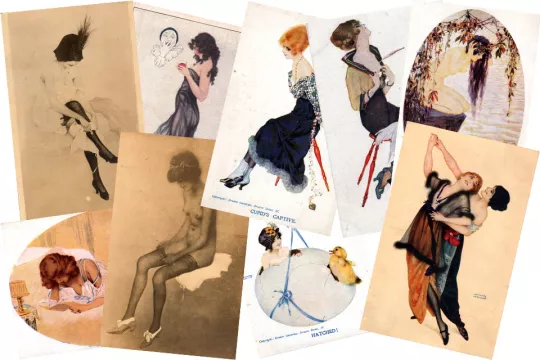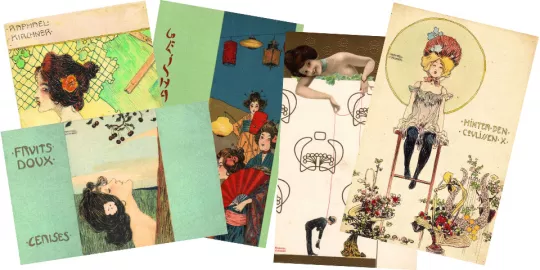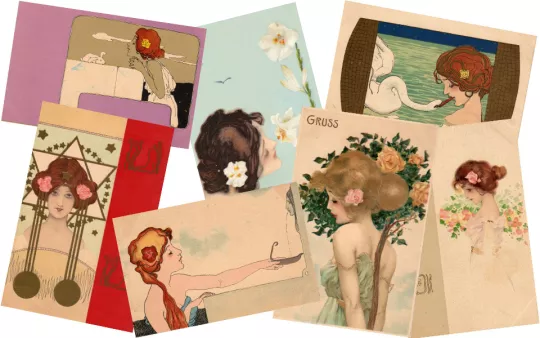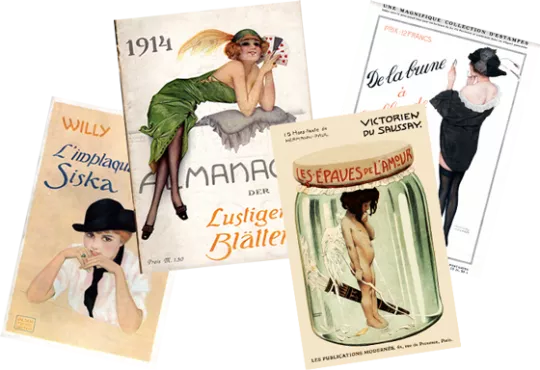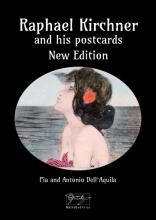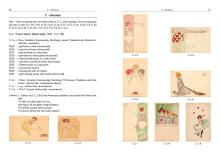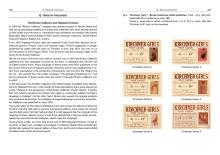Raphael Kirchner: non solo cartoline
Raphael Kirchner è stato uno degli illustratori di cartoline più prolifici tra la fine del XIX secolo e il 1917, anno della sua morte, all'età di 42 anni.
Kirchner è noto anche per essere un illustratore che si è dedicato essenzialmente al mondo delle cartoline, a differenza di altri illustri autori di cartoline, primo tra tutti Alphone Mucha, che ha tradotto in cartoline opere essenzialmente pensate per scopi più importanti, come poster, pannelli, menu, eccetera.
Le cartoline di Kirchner sono sempre le più richieste tra i temi artistici e circolano con grande successo non solo in Europa ma anche in America.
Nei primi anni della sua produzione, Kirchner si affidò a editori austriaci e tedeschi, tra cui Back & Schmitt, Stroefer, Munk, Sockl, Arenz e Storch.
All'inizio del 1900 Kirchner si trasferì a Parigi, affascinato dalla metropoli francese, brulicante di artisti famosi e altri in cerca di fama. Dall'autunno del 1902 iniziò a firmare le sue cartoline con l'aggiunta di "Paris" in onore della sua città adottiva.
Le sue cartoline più belle appartengono a questo periodo parigino trionfante, in cui i caratteri stilistici dell'Art Nouveau francese e dello Jugendstil tedesco si uniscono dando luogo a risultati sorprendenti nel rappresentare, anche se con situazioni e ambienti differenti, un soggetto affascinante e misterioso: quello della donna e delle sue emozioni.
Le deliziose donnine di Kirchner, bionde, castane o rosse e il cui fascino continua ad ammaliare molti collezionisti in tutto il mondo, ritraggono spesso la moglie dell'artista "la bruna, con gli occhi azzurri, Nina" che, anche nella più seducente delle pose, non risultava mai sull'orlo della volgarità.
Intanto l'epoca d'oro della cartolina volgeva al termine. Ma l'attività di Kirchner come illustratore di cartoline non si esaurì, bensì si andò evolvendo verso nuove forme. Non più disegni creati espressamente per cartoline ma disegni creati per altri scopi - come illustrazioni di libri, stampe, ecc. - da utilizzare poi anche per le cartoline.
Nel 1914, allo scoppio della prima guerra mondiale, Kirchner fu costretto a lasciare Parigi, dove non era più accettato a causa delle sue origini austriache.
Grazie a un gallerista che gli propose di lavorare a New York, si trasferì in America, dove incontrò un suo vecchio amico, Josef Urban, che lavorava per diversi impresari, tra cui Florenz Ziegfeld.
Il nome di Florenz Ziegfeld è una pietra miliare nella storia dello spettacolo e ancora oggi è sinonimo di quel genere di musical basato su costumi fantasiosi e scenografie elaborate e fantastiche.
Nel 1916 l'impresario americano aveva appena rilevato la gestione del Century Theatre, e così per coprire le grandi spese delle produzioni divenne socio di Charles Dillingham, manager di altre famose sale da concerto di New York. Josef Urban fu assunto per il restauro del teatro, ma aveva bisogno di un artista che potesse animare il foyer in un modo molto speciale.
Kirchner accettò volentieri di lavorare per Ziegfeld; nacque così una breve ma significativa collaborazione tra le due persone che, ognuna a modo suo, hanno magnificamente celebrato il fascino femminile.
Kirchner quindi progettò dieci pannelli per la decorazione del foyer del Century Theatre, utilizzando una tecnica che comprende acquerelli, tempera, china e matita, immortalando le attrici e le ballerine del musical The Century. Gli stessi pannelli sono stati riprodotti su una serie di cartoline, nota come "Les Amour de Pierrot".
Alla fine Raphael Kirchner aveva raggiunto quella fama che aveva desiderato sin dalla sua giovinezza. Era all’apice del suo successo e aveva davanti un futuro luminoso e finanziariamente sicuro, a giudicare dalle numerose richieste per i suoi dipinti, quando la morte lo colpì all'improvviso mentre lavora tra le sue tele e i suoi dipinti, nella sfavillante metropoli americana.
Era il 2 agosto 1917; Kirchner aveva 42 anni, quando un attacco di appendicite pose fine alla sua esistenza.
Ancora oggi, le sue cartoline sono ammirate e collezionate in tutto il mondo e le Kirchner Girls sono vive più che mai.
Rapahel Kirchner: not only postcards
Raphael Kirchner was one of the most prolific postcards illustrators between the late 19th century and 1917, when he died at the age of 42.
Kirchner is also known to be an illustrator who devoted himself essentially to the world of postcards, unlike other famous postcards’ authors, first of all Alphone Mucha, who translated works essentially designed for more important purposes (such as posters, panels, menu, etc.) into postcards.
Kirchner's postcards are always the most requested among the artistic themes and they circulate with great success not only in Europe but also in America.
In the early years of its production, Kirchner relied on Austrian and German publishers, including Back & Schmitt, Stroefer, Munk, Sockl, Arenz and Storch.
In the early 1900s Kirchner moved to Paris, fascinated by the French metropolis, teeming with famous artists and others in search of fame. From the fall of 1902 he began to sign his postcards with the addition of "Paris" in honor of his adopted city.
His most beautiful postcards belong to this triumphant Parisian period, in which the stylistic characteristics of French Art Nouveau and German Jugendstil come together, giving rise to surprising results in representing, even if with different situations and environments, a fascinating and mysterious subject: that of the woman and her emotions.
Kirchner's delightful little women, blonde, brown or red, and whose charm continues to bewitch many collectors all over the world, often portray the artist's wife "the brunette, with blue eyes, Nina" who, even in the most seductive of posed, was never on the verge of vulgarity.
Meanwhile, the golden age of the postcard was drawing to a close. But Kirchner's activity as a postcards illustrator did not end, but evolved into new forms. No more drawings created expressly for postcards but drawings created for other purposes - such as book illustrations, prints, etc. - to be used then also for postcards.
In 1914, at the outbreak of World War I, Kirchner was forced to leave Paris, where he was no longer accepted due to his Austrian origins.
Thanks to a gallerist who offered him to work in New York, he moved to America, where he met an old friend of his, Josef Urban, who worked for several entrepreneurs, including Florenz Ziegfeld.
The name of Florenz Ziegfeld is a milestone in the history of the show and still today is synonymous with that genre of musical based on imaginative costumes and elaborate and fantastic sets.
In 1916 the American impresario had just taken over the management of the Century Theatre, and so to cover the large expenses of the productions he became a partner of Charles Dillingham, manager of other famous concert halls in New York. Josef Urban was hired for the restoration of the theater, but he needed an artist who could animate the foyer in a very special way.
Kirchner gladly agreed to work for Ziegfeld; thus came a brief but significant collaboration between the two people who, each in their own way, magnificently celebrated the feminine charm.
Kirchner then designed ten panels for the Century Theatre foyer decoration, using a technique that includes watercolors, gouache, Indian ink and pencil, immortalizing the actresses and dancers of the musical The Century. The same panels were reproduced on a series of postcards, known as "Les Amour de Pierrot".
Eventually Raphael Kirchner had achieved the fame he had desired since his youth. He was at the height of his success and had a bright and financially secure future ahead of him, judging by the numerous requests for his paintings, when death suddenly struck him as he worked among his canvases and paintings, in the glittering American metropolis.
It was August 2, 1917; Kirchner was 42 when a bout of appendicitis ended his life.
Even today, her postcards are admired and collected around the world and the Kirchner Girls are alive more than ever.
Pia e Antonio Dell'Aquila sono stati da subito attirati dallo straordinario fascino che emana dalle cartoline di Kirchner. Sono stati ad incontri con specialisti nel collezionismo di cartoline in Italia e all'estero, hanno esaminato cataloghi d'asta, listini di vendita, visitato mercatini e fiere dell'antiquariato, scritto a collezionisti e commercianti di tutto il mondo. Così, più di vent'anni fa, decisero di pubblicare i risultati delle loro ricerche sulle cartoline di Kirchner, pubblicando il libro Raphael Kirchner and his postcards.
Nel frattempo, le loro ricerche sono andate avanti, la diffusione di Internet ha permesso scambi a livello globale, di materiali e informazioni. Da queste premesse è natoRaphael Kirchner and his postcards. New edition, presto andato esaurito. È oggi disponibile su Amazon una nuova edizione aggiornata: Raphael Kirchner's Postcards.
Pia and Antonio Dell'Aquila were immediately attracted by the extraordinary charm that emanates from Kirchner's postcards. They have been to meetings with specialists in post card collecting in Italy and abroad, they have examined auction catalogs, sales lists, visited antique markets and fairs, written to collectors and traders from all over the world. So, more than twenty years ago, they decided to publish the results of their research on Kirchner's postcards, publishing the book Raphael Kirchner and his postcards.
Meanwhile, their research has continued, the spread of the Internet has allowed for exchanges of materials and information on a global level. From these premisesRaphael Kirchner and his postcards. New editionwas born, which quickly sold out. A new, updated edition is now available on Amazon: Raphael Kirchner's Postcards.
